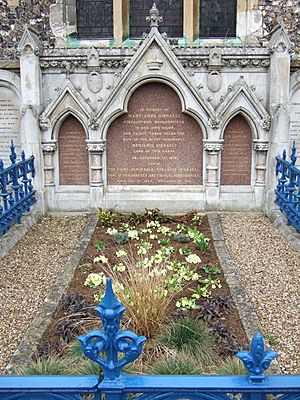Primrose Day facts for kids

Primrose Day was a special day that remembered the British leader and prime minister, Benjamin Disraeli. It was celebrated every year on April 19th, which was the day he passed away in 1881. People would place arrangements of primroses, which are small yellow flowers, at Disraeli's tomb and his statue in London. Many supporters also wore primroses on their clothes or hats. This tradition continued into the 1920s.
Contents
Who Was Benjamin Disraeli?
A British Prime Minister
Benjamin Disraeli was an important politician in Britain. He served as the country's prime minister twice. His first time was in 1868, and then again from 1874 to 1880. As prime minister, he was the head of the government.
Disraeli and Queen Victoria
Disraeli had a very good friendship with Queen Victoria. This friendship became even stronger after his wife passed away in 1872. It is said that the primrose was Disraeli's favorite flower. Queen Victoria would often send him bunches of primroses. These flowers came from her royal homes, like Windsor Castle and Osborne House. Disraeli always thanked the Queen for her flower gifts. He often mentioned how much he loved the primroses.
A Special Tribute
After Disraeli passed away, Queen Victoria sent a wreath of primroses to his funeral. A wreath is a circle of flowers. Her note with the wreath said, "His favourite flowers: from Osborne: a tribute of affectionate regard from Queen Victoria." This showed how much she cared for him. In 1882, Queen Victoria also unveiled a special memorial for Disraeli. It was placed at St Michael and All Angels Church, Hughenden, where he was buried.
How Was Primrose Day Celebrated?
The First Celebrations
The very first celebration of Primrose Day happened in 1882. A government worker named Sir George Birdwood helped make it popular. He wrote a letter to a newspaper, The Times. In his letter, he noticed that more primroses were being sold before the anniversary. He also suggested decorating places like St Stephen's Club with primroses.
Growing Popularity
The celebration was very successful in 1883. This success led to the creation of a group called the Primrose League. Artists also captured the spirit of the day. For example, Frank Bramley, an artist from the Newlyn School, painted a picture in 1885. It shows a young girl who has collected primroses on Primrose Day. She is sitting near a picture of Disraeli. Another artist, Ralph Todd, painted a similar scene.
Remembering Disraeli in the News
Even years later, people continued to remember Disraeli. In 1916, Pathé News, which made news films, recorded events for Primrose Day. They showed a wreath being placed at Disraeli's statue. This statue is located outside Westminster Palace in London. Pathé News continued to record these events through the 1920s. They showed important people like Austen Chamberlain in 1921 and Diana Churchill in 1928 taking part.
The Primrose League
What Was the League?
The Primrose League was a group started in 1883. Its main goal was to keep Disraeli's ideas alive. It wanted to spread and make popular traditional Conservative beliefs. These beliefs included supporting the British monarchy (the King or Queen), the British Empire, the Anglican Church, and free enterprise (businesses that are not controlled by the government).
Growth and Decline
A politician named Lord Randolph Churchill helped promote the League. He supported an idea called Tory Democracy. This idea aimed to unite all parts of society under Conservative values. The Primrose League grew very quickly. By 1887, it had over half a million members. By 1910, it had more than 2 million members. Both women and men joined the League in large numbers.
However, after the First World War, things changed. More people gained the right to vote. The Conservative Party started to focus on getting people to join the party directly. Because of this, the Primrose League slowly became less important. It was officially closed down in 2004.
Images for kids
-
Frank Bramley, 1885, Primrose Day, Tate Gallery
-
Ralph Todd, 1885, Primrose Day, Penlee House gallery
-
Wood engraving by W. Saull, showing Disraeli's statue in Parliament Square decorated with primroses on Primrose Day, published in Harper's Bazaar, 1886




